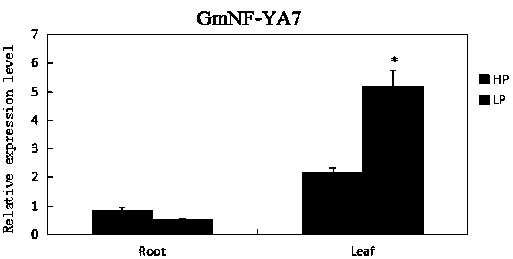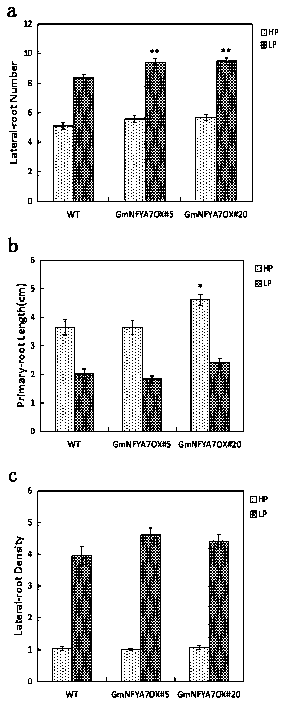Soybean low phosphorus response genes capable of promoting formation of lateral roots and protein and application of soybean low phosphorus response genes
A technology of protein and gene, which is applied in soybean low-phosphorus-responsive gene and its protein and application field to promote the formation of lateral roots, can solve problems such as unclearness and soybean adaptability to low-phosphorus stress, and achieve the effect of great commercial value
- Summary
- Abstract
- Description
- Claims
- Application Information
AI Technical Summary
Problems solved by technology
Method used
Image
Examples
Embodiment 1
[0033] Example 1 GmNFYA7 gene quantitative experiment
[0034] 1. Experimental method
[0035] 1. Quantitative PCR primer design
[0036] Download GmNFYA7 genome sequence (nucleotide sequence as shown in SEQ ID NO: 1), GmNFYA7 transcript sequence (nucleotide sequence as shown in SEQ ID NO: 2), GmNFYA7 CDS sequence (nucleotide sequence as shown in SEQ ID NO: 2) from website download NO: 3), GmNF-YA7 protein sequence (amino acid sequence is shown in SEQ ID NO: 4).
[0037] Design its specific quantitative amplification primers:
[0038] GmNFYA7.qF: CATGACCTCTCAGATAATGAAGC;
[0039] GmNFYA7.qR: TGCAAGTATGGCTTCCGAT.
[0040] 2. Planting of soybean materials and treatment of phosphorus deficiency
[0041] a. Seed disinfection
[0042] Mature, plump soybean seeds are arranged in a single layer in a Petri dish, placed in a desiccator, and the Petri dish is opened with the lid next to the Petri dish. Add 100ml of sodium hypochlorite to a 250ml beaker in a desiccator, then slowly ...
Embodiment 2
[0062] Embodiment 2 GmNFYA7 gene overexpression vector construction (gateway method)
[0063] 1. Experimental method
[0064] 1. Primer design
[0065] Download the GmNFYA7 gene CDS sequence (nucleotide sequence as shown in SEQ ID NO: 3) from the website, design its specific amplification primers,
[0066] OE-GmNFYA7.F:
[0067] gggacaagtttgtacaaaaaagcaggcttcTCATGTGTGTAGATTGGGACACTG;
[0068] OE-GmNFYA7.R:
[0069] ggggaccactttgtacaagaaagctgggtcCTTAGGATGTTCTATCTGATGGTGC.
[0070] 2. Fragment amplification and purification
[0071] Using the cDNA of soybean YCO3-3 as a template, use the specific primers of OE-GmNFYA7 to amplify the corresponding fragment. The reaction system and reaction conditions are shown in Table 3 and Table 4 below; run the PCR reaction product on agarose gel electrophoresis, and match the position The bright band was excised and recovered, and then the PCR product was recovered using an agarose gel DNA recovery kit to obtain the target fragment.
...
Embodiment 3
[0087] Embodiment 3 Arabidopsis genetic transformation
[0088] 1. Experimental method
[0089] 1. Planting of wild-type Arabidopsis (Col-0)
[0090] Sow the wild-type Arabidopsis seeds (Col-0) evenly on the surface of the nutrient pot with the substrate, spray some water, then cover it with a plastic film to keep it moist, and put it in the dark at 4°C for 2 to 3 days to break it. Seed dormancy.
[0091] Then placed in an artificial climate chamber (16 hours of light at 24°C / 8 hours of darkness at 24°C) for cultivation, waited for a week, and then transplanted into nutrient pots respectively, with 3 to 4 plants in each pot, when the first bolting 1cm , cut off the main stem to increase the number of branches, and when Arabidopsis blooms next time, it can be transformed with Agrobacterium liquid.
[0092] 2. Transformation of Arabidopsis flocs with Agrobacterium liquid
[0093] The Agrobacterium GV3101 preservation solution carrying the target vector (the GmNFYA7 gene over...
PUM
 Login to View More
Login to View More Abstract
Description
Claims
Application Information
 Login to View More
Login to View More - R&D
- Intellectual Property
- Life Sciences
- Materials
- Tech Scout
- Unparalleled Data Quality
- Higher Quality Content
- 60% Fewer Hallucinations
Browse by: Latest US Patents, China's latest patents, Technical Efficacy Thesaurus, Application Domain, Technology Topic, Popular Technical Reports.
© 2025 PatSnap. All rights reserved.Legal|Privacy policy|Modern Slavery Act Transparency Statement|Sitemap|About US| Contact US: help@patsnap.com



